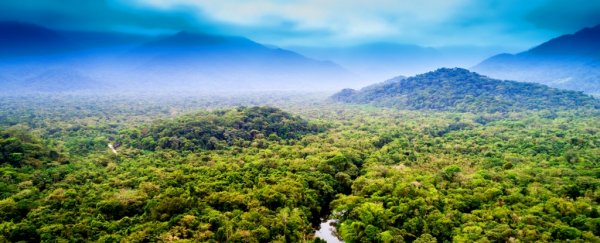The vast footprint of the Amazon rainforest isn't just a natural wonder. It's also a place of mystery and myth – a glorious backdrop to a rich history of ancient societies whose precious ecosystem is now threatened by the murderous expansion of mining greed.
Now, that rich history is set to grow deeper still.
A new study reveals unexplored parts of the Amazon assumed to have been uninhabited before the arrival of Columbus could actually have been home to a vast network of up to 1 million people, spread across an 1,800 kilometre (1,118 mile) stretch of the rainforest's southern rim.
 (José Iriarte)
(José Iriarte)
That's the hypothesis of archaeologists led by the University of Exeter in the UK, who used satellite images to survey the upper Tapajós Basin in Brazil, discovering 81 new archaeological sites encompassing a total of 104 earthworks – historical evidence of soil engineering in the Amazon's southern landscape.
These kind of earthworks – which sometimes take the shape of geoglyphs – have been discovered before in the Amazon, and when we find them, they reveal the existence of human activity long hidden by the rainforest's dense foliage.
In the new investigation, the team found evidence of numerous fortified villages, dating to 1250‒1500 CE. Conducting surveys on the ground at 24 of these sites, they discovered ceramics, polished stone axes, anthropogenic dark earth (fertilised soil), and middens (domestic waste dumps).
The sites the team found ranged from small, ditched enclosures measuring approximately 30 metres (almost 100 ft) in diameter through to large much larger fortifications stretching for 400 metres (over 1,300 ft) and consisting of numerous mounds connected by plazas and sunken roads.
 (José Iriarte)
(José Iriarte)
What's amazing about all this, apart from the sheer scale of some of these long-hidden structures, is the Tapajós Basin was thought to be largely uninhabited by researchers who study pre-Columbian South American civilisations.
They'd always assumed populations centred around resource-rich floodplains and riverbanks in other parts of the Amazon.
"There is a common misconception that the Amazon is an untouched landscape, home to scattered, nomadic communities," says one of the team, archaeologist Jonas Gregorio de Souza.
"This is not the case. We have found that some populations away from the major rivers are much larger than previously thought, and these people had an impact on the environment which we can still find today."
What's even more remarkable is the potential scope of this undiscovered population.
 (José Iriarte)
(José Iriarte)
The researchers' estimates, based on the distribution and size of the earthworks uncovered so far, suggest an overall population of between 500,000 to 1 million people could have once thrived within these 'uninhabited' parts of the Amazon.
They were spread out over a vast geography of some 400,000 square kilometres (154,000 square miles), in up to as many as 1,500 separate enclosures.
Of course, that's just a hypothetical extrapolation for now, but if it's right, it means the overall population of the pre-Columbian Amazon as a whole was far greater than we ever knew – holding a richer, more diverse mix of cultures and traditions that are still lying in wait to be discovered.
The findings are reported in Nature Communications.
